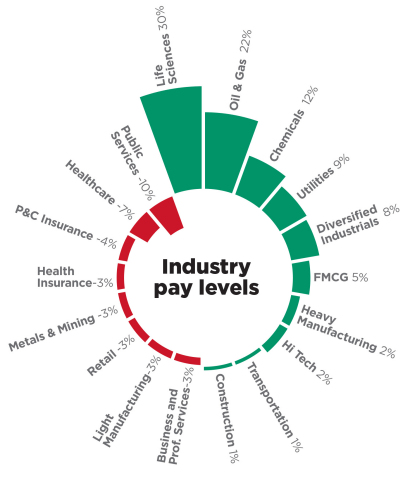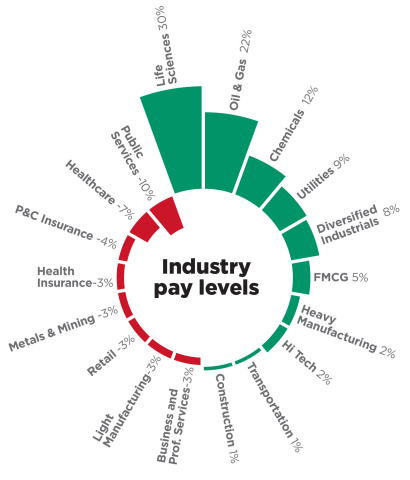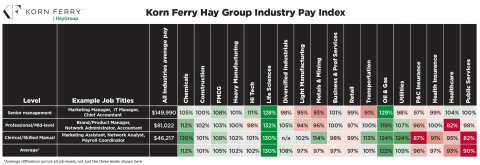LOS ANGELES--(BUSINESS WIRE)--According to new research by the Hay Group division of Korn Ferry (NYSE: KFY), the preeminent global people and organizational advisory firm, workers in the oil and gas, chemicals and life sciences industries out-earn their peers in other industries. Conversely, employees in retail earn well below the average pay of their peers, when looking across all industries.
The study findings come from an analysis of senior manager, mid-level and clerical pay across 78 countries included in Hay Group's PayNet database.
Highly Technical Skillsets Pay Off
Toward the top of the list of highest paying industries around the globe, the chemicals (9 percent above the average) and life sciences (8 percent above the average) industries pay higher than average wages across the board. Despite the current trends in the oil and gas industry, Hay Group analysis found this sector to be the top payer at the global level, coming in at 22 percent above the average pay across all industries.
At the bottom end of the scale, the retail sector typically pays 12 percent below the average, while the construction and services industries both pay 4 percent less than the overall average.
“As global economies continue to grapple with weak consumer spending, it’s little surprise we see industries more reliant on hourly wage labor at the bottom of our ranking, worldwide,” said Ben Frost, a consultant at Hay Group. “Comparatively, industries where labor is concentrated in highly technical roles, including engineering and scientific functions, have fared much better as far as employee pay is concerned.”
U.S. Industries Trend Higher, But Pay Varies Across Levels
In the United States, the life sciences industry emerges at the top of the Hay Group analysis, paying 30 percent more than the average pay across all industries and title levels. Oil and gas comes in a close second, at 22 percent above the average, followed by chemicals (12 percent above the average) and utilities (9 percent above the average). On the other hand, public services, including state and federal government employees, mark the low end of the scale, typically paying employees 10 percent less than the all industries, all title levels average. The health care industry pays 7 percent less than the overall average, followed by property and casualty insurance (4 percent below the average) and health insurance (3 percent below the average).
“As on the global level, we’re seeing highly technical STEM-focused roles paying off for workers in the United States, while government roles hold the bottom slot in our study,” noted Frost. “On the health care, property and casualty insurance and health insurance side, these industries necessarily include a large number of administrative rolls, in claims processing and similar functions, which tend to drive down the overall pay levels seen in our analysis.”
Pay Trends Largely Consistent Across Title Levels
Hay Group analysis also examined pay within industries in the United States across three key title level brackets: clerical or skilled manual employees (ex. Marketing Assistant, Network Analyst, Payroll Coordinator, etc.), professional/mid-level employees (ex. Brand/Product Manager, Network Administrator, Accountant, etc.) and senior manager (ex. Marketing Manager, IT Manager, Chief Accountant, etc.).
When looking at pay within industries on the basis of these title levels, the analysis found pay trends remain largely consistent – that is, those industries that pay more on average, pay more across all title levels, while those that pay less, pay less across all levels.
According to the study, many industries see employee pay trend above the average more often for lower level staff than for more senior executives. For example, the chemicals industry typically pays clerical or skilled entry level staff 20 percent more than the all industries average, or about $55,460. Senior managers in the same industry, however, tend to make only 5 percent more than the average, or about $157,490. Similar trends emerge in the utilities, transportation, manufacturing, construction, metals and mining, and consumer goods industries.
Life sciences (30 percent above the average), utilities (24 percent above the average) and oil and gas (24 percent above the average) lead the way in above-average employee pay at the clerical and skilled manual title level. At the senior manager level, oil and gas (29 percent above the average) and life sciences (28 percent above the average) continue to lead, and are joined by the high tech (11 percent above the average) industry in providing the highest boost over average pay for senior employees.
“As overall pay increases at more senior levels, pay moves toward the norm across all industries, as each percentage point above or below becomes relatively more expensive,” explained Frost. “At less senior levels, paying employees 10 percent or even 20 percent more than the average represents a smaller cost to employers than a 10 percent bump at the senior manager level.”
Please note: This study should be credited to “Korn Ferry Hay Group,” and not “Hay” or “Hays,” which are separate and unrelated organizations.
About the study
The data was drawn from Hay Group’s PayNet database which contains data for more than 20 million job holders in 24,000 organizations across more than 110 countries.
About Korn Ferry
Korn Ferry is the preeminent global people and organizational advisory firm. We help leaders, organizations, and societies succeed by releasing the full power and potential of people. Our nearly 7,000 colleagues deliver services through our Executive Search, Hay Group and Futurestep divisions. Visit kornferry.com for more information.





